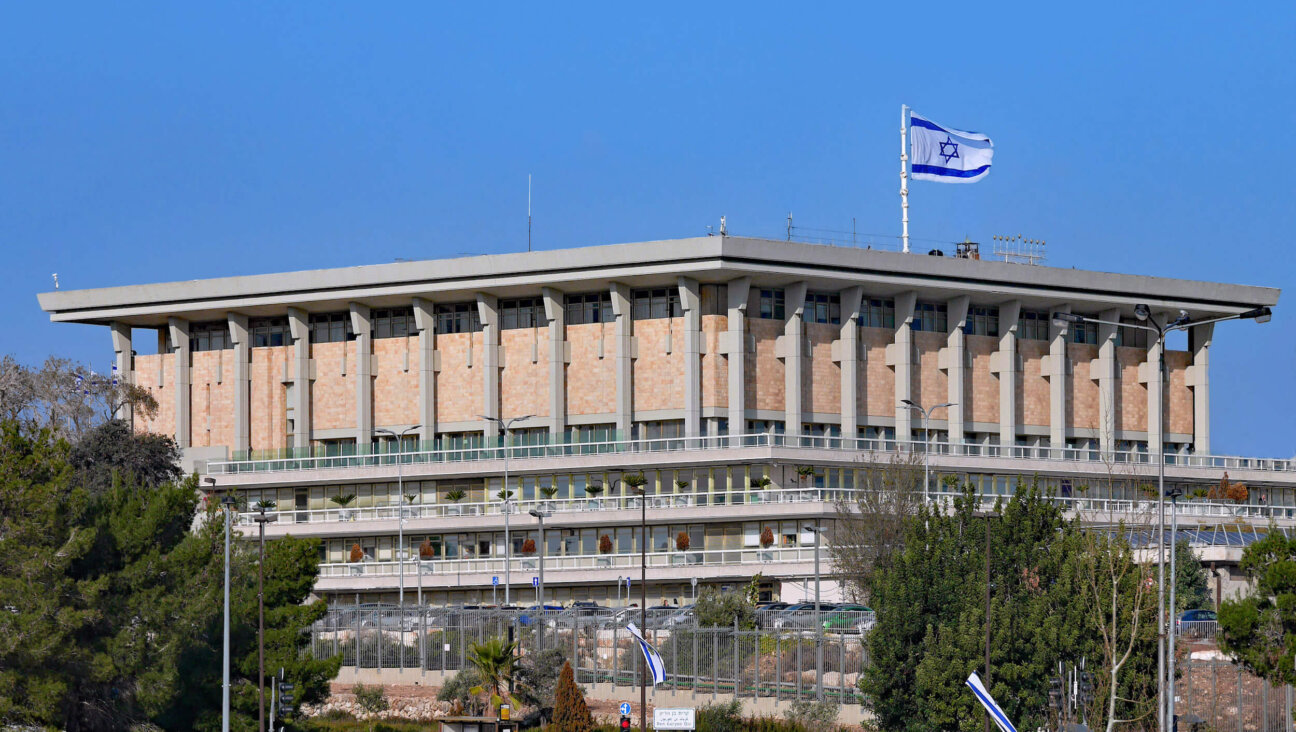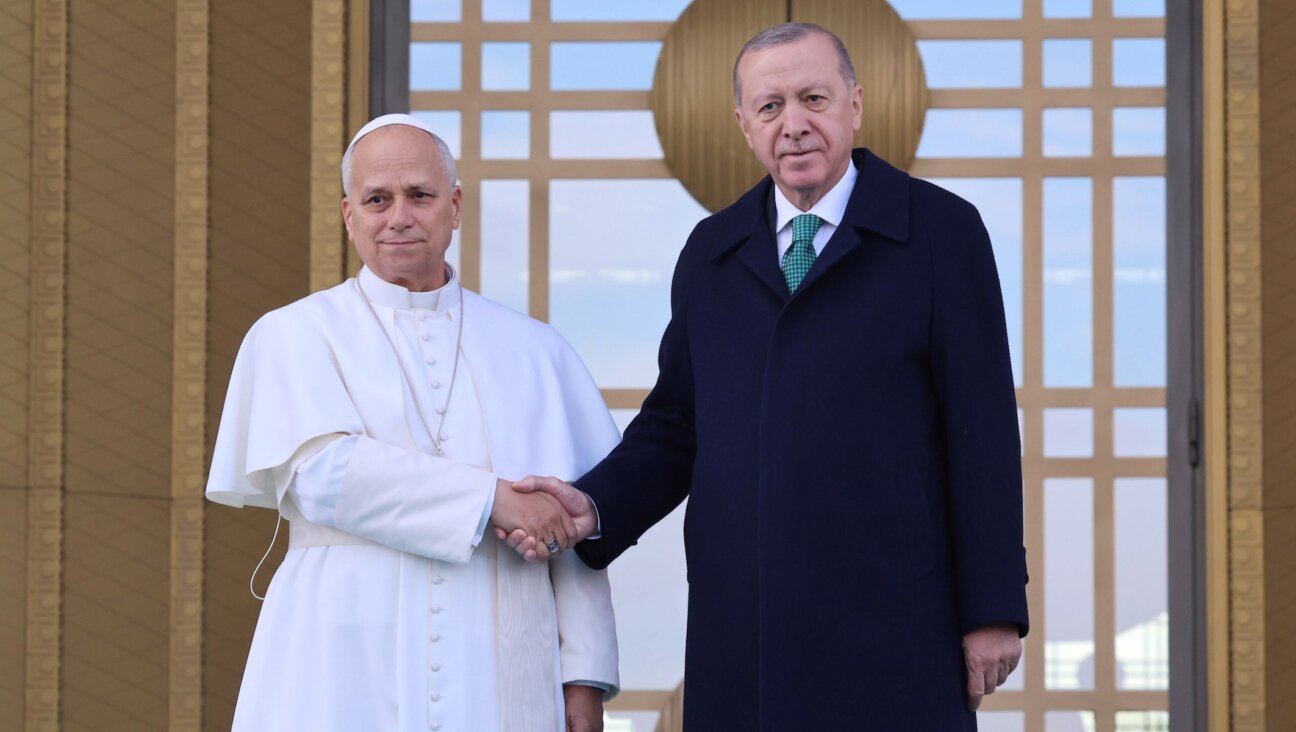Solving the Mystery of Washington’s Famous Letter

Graphic by Angelie Zaslavsky

Hand-Off: Moses Seixes presenting the letter from the Hebrew Congregation of Newport to President George Washington. August 18, 1790, in the Colony House, Newport. Image by Steve Brosnahan, © George Washington Institute for Religious Freedom
It started as a mystery.
During a lecture in England last December, Jonathan Sarna, America’s foremost scholar of American Jewish history, said he did not know the whereabouts of one of American Jewry’s most important documents: George Washington’s letter to the Hebrew Congregation, in Newport, R.I.
Upon this yellowed piece of 18th-century rag paper is a short but powerful statement from the first president of the United States reassuring one of the original colonial congregations that his nascent government guaranteed religious liberty for all.

Keepsake: A copy of Washington?s letter to the Jews of Newport, found in the letter book of the President?s secretary. Click to enlarge image. Image by Library of Congress, Manuscript Division
“For, happily,” Washington wrote to the Jews of Newport in 1790, “the Government of the United States, which gives to bigotry no sanction, to persecution no assistance, requires only that they who live under its protection should demean themselves as good citizens in giving it on all occasions their effectual support.”
More than a vital piece of American Jewish history, the letter is one of the primary documents guaranteeing religious tolerance in America, its famous words still quoted by community leaders and politicians whenever they want to underline America’s commitment to religious liberty.
But where is the letter?
After months of searching, the Forward has found the elusive letter in an art storage facility in a squat, nondescript building in an industrial park in Maryland, a stone’s throw from the home of the Washington Redskins, at FedEx Field. The letter is owned by the Morris Morgenstern Foundation and has been on loan to the B’nai B’rith Klutznick National Jewish Museum for more than 50 years.
The letter has not always been hidden from sight — it was originally displayed in the exhibition hall of B’nai B’rith International’s headquarters, on Rhode Island Avenue, in Washington. But when B’nai B’rith sold that building and moved to smaller offices in 2002, there was no longer space for the entire collection, and so a significant portion of it was put into storage.

Letter: Morris Morgenstern (center) presents a copy of Washington?s letter to President John F. Kennedy as PR guru Howard Rubenstein (right) looks on. Image by courtesy of howard rubenstein
Over the years, the Library of Congress asked for permission to exhibit the letter, as did the new National Museum of American Jewish History. All requests were denied. During the Forward’s investigation, it became clear that many scholars did not even know where it was, who owned it and why it was not on public view.
B’nai B’rith would not give permission to publish a photograph of the original letter in the Forward.
Washington’s correspondence to Newport’s Hebrew Congregation is not the only letter he wrote to the Jewish community at that time. Washington wrote two more letters: one to the community in Savannah, Ga; the other, a combined letter to the communities in New York; Philadelphia; Charleston, S.C., and Richmond, Va.
Newport was singled out, Sarna explained, as part of a public relations campaign Washington waged on behalf of the new U.S. Constitution. Though the Constitution needed to be ratified by only nine of the original 13 states, Washington wanted a unanimous vote. “Rhode Island was the great holdout,” Sarna said, “because it thought that it would be bullied into signing.”
So Washington made a deal: If Rhode Island approved the Constitution, Washington and his entourage would personally make a state visit there.
After Rhode Island ratified the Constitution, Washington and Thomas Jefferson toured the state in August 1790, stopping in Providence and Newport.
In Newport, Moses Seixas, president of the local congregation, presented a communication on behalf of the Jewish community, praising Washington’s victory and giving thanks for the establishment of a government that guaranteed “civil and religious liberty.”
Indeed, were it not for Seixas’s eloquence — his letter expressed gratitude for the establishment of “a Government, which to bigotry gives no sanction, to persecution no assistance” — then perhaps Washington’s response, which copies Seixas’s phrasing almost word for word, would not be nearly as powerful as it is today.
Steve Frank, chief interpretative officer of the National Constitution Center, said that Washington replied to many religious groups and communities in those days. But the Newport letter is special precisely because of the language. “The ringing tones of the declaration really set it apart,” Frank said.
But when Frank was asked where he thought the letter was, he, like Sarna, was unsure.
Other scholars were puzzled, too. Susan Malbin, director of library and archives at the American Jewish Historical Society, said she did not know where to find the letter. Sharon Mintz, curator of Jewish art at the library of the Jewish Theological Seminary, did not know where to find it either. Neither did Tony Michels, professor of history and Jewish studies at the University of Wisconsin-Madison, nor Zachary Baker, curator of the Judaica and Hebraica collections at Stanford University.
Finally, Sharon Bender, B’nai B’rith’s spokeswoman, said that a private organization, the Morris Morgenstern Foundation, owned the letter and had loaned it to B’nai B’rith about 50 years ago. “Our current offices do not have space for a museum,” she wrote in an e-mail. “Therefore, the letter is now stored in a climate-controlled fine arts storage facility and is not readily accessible.”
If you want to see the Declaration of Independence, you can go to the National Archives. If you want to see Washington’s letter to the Jews of New York, Philadelphia, Charleston and Richmond, you can go to the new Jewish history museum in Philadelphia.
But if you want to see Washington’s letter to the Jews of Newport, you have to drive about 25 minutes from downtown Washington, to an art storage facility in suburban Maryland. And you’re not allowed to ask any questions.
Such were the conditions laid down by B’nai B’rith for the Forward’s June 10 visit to Artex Fine Art Services. There, in a warehouse, atop a palette covered by a blue drop cloth and flanked by two Artex employees and Cheryl Kempler, the museum’s sole remaining employee, is Washington’s letter.
The letter is extremely sensitive to light, heat and humidity. Even during the Klutznick Museum’s heyday, when it attracted about 40,000 visitors a year, the document was on display only a couple of months of the year.
The Artex employees ensured that the temperature in the warehouse was carefully controlled. Dwarfed by towering shelves and enormous, canvas-shaped cardboard boxes, the 220-year-old letter looked fragile. There are no distinguishing features — no letterhead, stamp or seal — just row upon row of very straight, handwritten lines.
Ahead of this visit, James Hutson, chief of the manuscript division at the Library of Congress, had advised that the most important factor to note was the condition of the paper. To the untrained eye, the letter looked fine. It was resting on what seemed to be a piece of cardboard and had been covered by what looked like acid-free paper.
“The lines are very straight,” Bender said.
Anyone who has tried to chase down the whereabouts of Washington’s letter has ended the search at the Morgenstern foundation.
Morgenstern’s life — he died in 1969 — has a Horatio Alger ring to it that is common to Jews of a certain era. He grew up on Manhattan’s Lower East Side in the late 19th century, and made his first living selling newspapers and shining shoes.
Somehow, he parlayed such humble beginnings into a career as a wealthy financier and philanthropist who, according to The New York Times, often claimed to have “the most diversified philanthropic portfolio in the United States.”
“He was an exuberant person,” said Howard Rubenstein, a New York PR guru whose clients include the New York Yankees and Rupert Murdoch. “He was short — maybe 5’ 2” — but he was very tall in spirit.”
Fifty years ago, Morgenstern was Rubenstein’s first big client. And Washington’s letter was the fulcrum around which their relationship revolved.
“He cherished the letter,” Rubenstein said. “There were many times when he slept with it under his bed.”
Because Rubenstein knew how much Morgenstern loved the letter, he suggested that a special award be created in its name. Following that advice, Morgenstern had a copy of the letter framed and would present it to prominent people, along with a donation to a charity of their choice.
Over the years that followed, Rubenstein said he arranged audiences with former presidents Herbert Hoover and Harry Truman and with future presidents John F. Kennedy and Lyndon Johnson. The photograph from at least one of those meetings has pride of place on the wall in Rubenstein’s Midtown offices. “Everywhere we went,” Rubenstein said, “if I said we have the letter, the doors opened; and Morris loved the glory of promoting that language.”
After Morgenstern died, Rubenstein lost touch with his family. But he did say that he knew the sole director of the foundation, Morgenstern’s son Frank.
“Frank was always very reluctant to take center stage in terms of publicity,” Rubenstein said. “He was very modest.”
Frank Morgenstern is, indeed, a private man. Paul Goodnough, an accountant who answered the phone registered to the Morris Morgenstern Foundation, said Morgenstern did not want to speak to a reporter. “They’re very private people,” he said of the family.
It’s unclear exactly when Morgenstern bought the letter or for how much. An article in the New York Amsterdam News in 1951 claimed that Morgenstern acquired the letter in 1949. The most recent public filings for the foundation list among its assets “historical documents” that, it says, were purchased for $15,000 and currently have a “market value” of $300,000.
But the actual value of the letter is likely much higher.
Seth Kaller, a dealer in rare coins and documents, said the most recent sale of a George Washington letter, at Christie’s in 2009, fetched $3.2 million. David Redden, a Sotheby’s vice chairman, estimated that the Newport document would likely fetch between $5 million and $10 million today. “It’s an astonishing letter,” he said.
For now, anyone willing to see copies and reproductions of Washington’s letter has very few options.
The foundation recently gave permission for the owners of the newly built Ambassador John L. Loeb Jr. Visitors Center, in Newport, to re-photograph the letter. The center, close to the historic Touro Synagogue, used the high-resolution photographs for its multimedia exhibit, which is run by the George Washington Institute for Religious Freedom.
But such acts of beneficence by the foundation are rare. It has maintained a tight grip on the rights to the letter.
That is why there is no photograph of Washington’s letter accompanying this article.
In response to a request for an image, the museum said, “B’nai B’rith International does not grant permission for that photo to be published by the Forward.”
Even the new NMAJH was refused permission to display a photograph of the letter. “We do display a reproduction of the letter,” said Michael Rosenzweig, president and CEO. “It’s a facsimile of a reproduction of the letter, written by Washington’s secretary.”
Indeed, this facsimile of the copy of Washington’s letter, which was noted in Washington’s secretary’s letter book and is owned by the Library of Congress, is often used in place of the original letter.
Rosenzweig said he would prefer to have the original letter, or even a facsimile of the original letter. He said that B’nai B’rith had even asked the foundation, on the museum’s behalf, for permission to display Washington’s letter.
Bender, B’nai B’rith’s spokeswoman, said that the museum “would be a wonderful venue for this important letter.” She could not say why the request had been denied. “You’d have to ask the Morgenstern Foundation,” she wrote in an e-mail.
“We are the only museum anywhere dedicated exclusively to telling the story of American Jewish history, and as the National Museum of American Jewish History, we would love to be able to display that letter here,” Rosenzweig said.
Steve Frank at the Constitution Center said that, in one sense, the foundation and the museum were doing everything right.
From the perspective of preservation, keeping the letter out of sight and in climate-controlled conditions would safeguard its future for centuries to come.
“But from the public’s perspective,” Frank added, “the opportunity to see that letter and to be connected to that history would just be enormously powerful.”
Contact Paul Berger at [email protected]
















